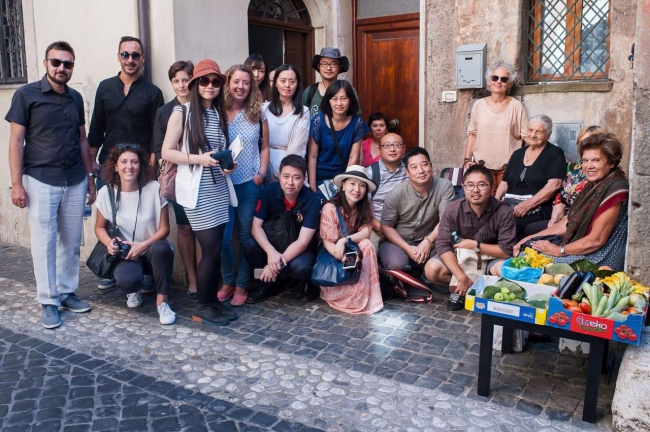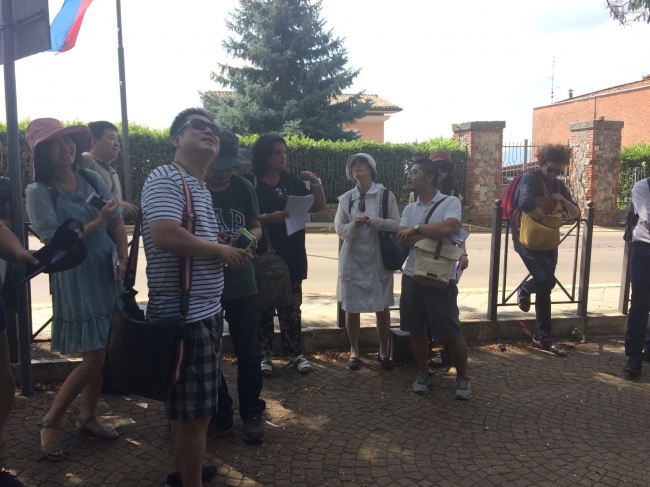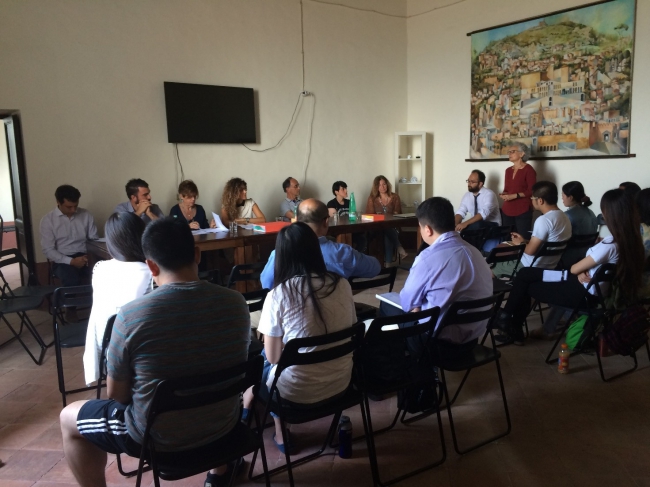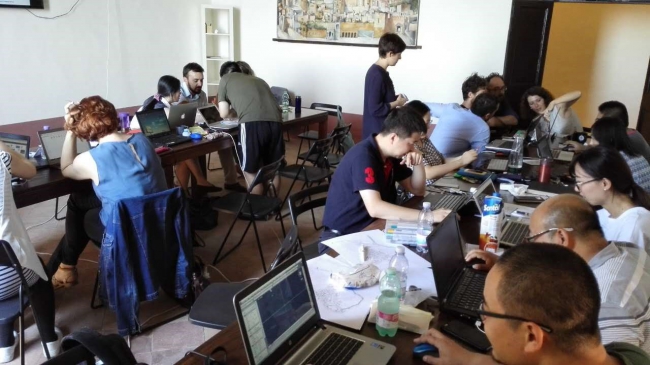| The first edition of the “HUL Bridging Cultures - HULBriC” training in situ course finished successfully |
| Author:Porfyriou, H. & Pola, A.P. PublishDate:2016-09-12 Hits:3723 |
The first edition of the “HUL Bridging Cultures - HULBriC” training in situ course (27 August- 4 September 2016), has ended on Sunday September 4th.
Group photo
The Course coordinated by the Institute for the Conservation and Valorisation of Cultural Heritage of the National Research Council of Italy (CNR-ICVBC-Rome) in collaboration with the WHITRAP was organised by CNR-ICVBC and the University of Rome Tor Vergata and had as partners and co-organisers the Municipalities of Palestrina and Castel San Pietro Romano and the Regional Agency Lazio Innova S.p.A.
Based on the HUL approach, the training, addressed issues relative to small historic towns’ conservation, valorisation and management with the aim to bridge different cultures, and more specifically Sino-Italian experiences, and best practices in an interdisciplinary and comparative way. Focusing on selected heritage pilot cases it was built on the Italian expertise on the subject, bringing together in situ training, multidisciplinary workshops and studios with the aim to study and propose a conservation/valorization project for the selected pilot case areas. Training was, thus, integrated with problem solving and the course participants with local stockholders and residents.
Site visit
Meeting with local stakeholders
Studio
More specifically, considering HUL as an approach aiming to overcome the distinction between conservation and transformation – while promoting conservation as management of change – the training was structured and built on the best experiences of Italian conservation history and legislation as exemplified through three major keywords: physical urban and architectural conservation, integrated landscape, local participation.
Small historic towns were selected as the core study because they represent the most authentic depository of traditional cultural values related to: built heritage -- in terms of conservation techniques, materials and craftsmen’s presence; intangible heritage traditions; landscape qualities and relationship to nature (both in productive and aesthetic terms); and local identity values, often expressed in a strong participatory citizenship.
Historic small towns represent the 80% of Italian cities. However, also China has an amazingly rich heritage dispersed in traditional villages and small towns, often unknown to the West and still not well documented, conserved and valorised. Enhancing it may bring not only tourism and resources, also to non-urban areas, but may re-equilibrate unsustainable urbanisation.
Italy is famous worldwide for its longstanding urban history and amazingly stratified cities, which fostered the country’s interest in restoration interventions and conservation theories since late 19th century. This Italian expertise in architectural and urban conservation were considered crucial for the HUL implementation in small historic towns, and were proposed throughout the course’s lectures and visits, together with integrated valorisation and management approaches based on ICT tools. The aims of the Course were: - to offer a highly qualified and professionalized training to both Chinese and Italian participants disseminating Italian expertise on the subject; - to bring the issue of small historic towns up in the heritage conservation agenda, worldwide; - to have a positive impact on the host cities and the citizens local identity. They were achieved by: - selecting participants with high professional profiles, able to become the direct disseminators of the HUL approach implemented to small historic towns; - organising an in situ training. That is, by offering the opportunity to the participants to touch, see, breath, be immerged, experience the qualities of space, urban life, landscape and of the hosting of small historic towns; - training to sense without maps the urban space qualities and to feel the materials, to appreciate the context and to see with the other’s eyes; - an intercultural (China –Italy) and interdisciplinary approach: art and architectural history, urban planning history, archaeology, planning, communication, ICT, economics, are some of the disciplines involved in the teaching program; - bringing together professionals and academics, students and practitioners; - en charrette studios: introducing intensive studios on case studies and problem solving; - involving citizens and local stakeholders in the whole training process, both as hosts and as evaluators. This Course will be annually promoted in Italian small historic cities and hopefully soon also in Chinese traditional towns with the aim to: 1) define an inedited training format able to become a part of the HUL toolkit and therefore a useful tool worldwide; 2) offer to participants a deeper understanding of urban conservation; skills for digital valorisation and communication; a critical approach to integrated solutions incorporating public participation in heritage development and to promote cultural exchanges while bridging cultures. However, its ultimate goal is to impact also on small historic towns’ development and conservation by enhancing local identity and prestige, economic valorisation and tourist flows, while promoting inedited solutions to the urban conservation/valorisation issues local communities identify as crucial and offer as case studies for the en charrette studios. |
- News | WHITRAP Shanghai and CNR-ISPC bilateral meeting
- News | WHITRAP meets Cité de l’Architecture et du Patrimoine
- WHITRAP Hosting "Workshop on Preliminary Assessment for National Focal Points of the Asia Region" in Chengdu
- WHITRAP Shanghai meets UNESCO
- INTERNATIONAL CONFERENCE PRELIMINARY ANNOUNCEMENT & CALL FOR PAPERS
- Observation of the 46th Session of the World Heritage Committee
Copyright © 2009-2012 World Heritage Institute of Training and Research-Asia and Pacific (shanghai)






